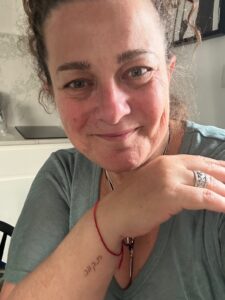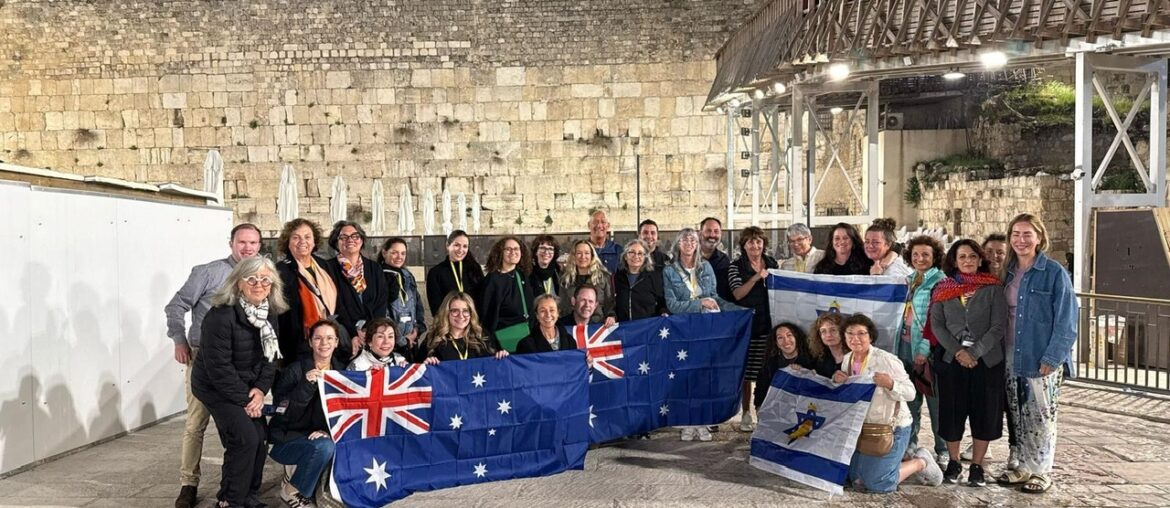For the second year in a row, Jews around the world gathered to celebrate Passover—our annual commemoration of freedom from slavery, while 59 of our brothers and sisters remain hostage in Gaza. The irony and the heartbreak was not lost on any of us.
Twenty-seven years ago, I set off to celebrate Passover in Israel and I could never have imagined it would take me nearly three decades to return, and certainly not under the circumstances that finally brought me back.
I went to Israel because I needed to be there as much as I needed air to breathe. The anger, frustration and hopelessness I felt in the 18 months following the horrors of October 7 had become suffocating.
I was angry at the way history was being rewritten by anti-Zionists. Angry that Jewish women were not believed, even with testimonies documenting the sexual violence of that day and the months that followed. Angry at the rise in antisemitism across every facet of life in Australia. Angry that using my voice in support of Israel had all but cost me my business, but most devastating was that decades of advocacy had amounted to nothing. I felt like a failure. The challenges seemed insurmountable.
There were moments of joy, but a cloud of hopelessness weighed me down, always the heaviness, the ache, and the belief that somehow, being in Israel might ease it. Ironic I know, to leave the comfort of home and travel to a war zone in search of inner peace.
With my family’s blessing I went, but not for a holiday, for a homecoming. I applied to join the inaugural Project A “Mission With a Mission” organised by a powerhouse team of women, together with the Australia Israel Chamber of Commerce. The six-day program offered a balance of advocacy training and cultural immersion. I committed to five weeks in Israel: a few days to settle in, six days on the mission, and three weeks to find volunteer opportunities to run art classes.
One doesn’t fly into a Middle East war zone without some trepidation, but when the captain announced our descent into Ben Gurion Airport, I burst into tears of relief and joy. That joy was short-lived. The walkway to customs was lined with posters and memorials for the 59 hostages still in captivity and my tears of joy turned to tears of grief. In Israel, that feeling is unavoidable. From Hostage Square to Sderot, from Jaffa to Jerusalem, their faces are everywhere. After 18 months, the pain is raw. It is an open wound that hurts the entire country.
Project A was a masterclass in understanding Israel’s challenges, strength, and spirit. Our first speakers were former ambassadors Mark Regev and Mark Sofer. We heard from voices across the political spectrum, some certainly controversial, but all a crucial component in becoming better, more informed advocates. We learned from Arab Israeli journalist Khaled Abu Toameh, former MK Einat Wilf, authors, journalists, communications experts, and Australia’s Ambassador to Israel, Dr. Ralph King.
Among the most unexpected highlights was our session with rocket scientist Dr. Ari Sacher at Rafael—the heart of Israel’s defensive tech innovation. Dr. Sacher captivated us with insights into Israel’s Iron Dome, drone and laser technology, and the military precision that is critical in attacking our enemies while protecting innocent lives on both sides of the war. His words gave us something precious: a sense of security.
That security was soon tested. The ceasefire broke, and our group experienced our first 4am air raid siren and bleary-eyed dash to a bomb shelter. While 95% of incoming rockets are intercepted by the Iron Dome, their purpose isn’t just destruction, it’s disruption. They exist to make daily life unbearable, to exhaust and terrify. It’s psychological warfare. I heard from teachers whose young students are too tired to concentrate in class, and new mothers afraid to leave their homes with their babies in cars or strollers for fear of being caught unprotected during sirens. This is what the world doesn’t see, nor do they see the resilience of Israelis who, despite their reality still get up each day and live, really LIVE their lives.
Amid the intensity, there were also moments of levity. We laughed with storyteller Sarah Tuttle-Singer and filmmaker-comedian Lee Kern. We wept with rescued hostage Luis Har and the bereaved families of Nova victims. We explored graffiti alleys, visited the Peres Center for Peace and Innovation, wandered the shuk on a food tour, and paid our respects at Mount Herzl. We prayed at the Western Wall (Kotel), danced, and sang HaTikvah.
As I pressed my forehead to the ancient stone of the Kotel I said the prayer Shema Yisroel and placed dozens of prayers I had brought with me from strangers, family and friends into gaps in the wall. My overwhelming emotion reflected my belief that this was the destination I’d been aching for. I found myself asking for guidance going forward, finally understanding that this wasn’t a destination but the threshold of what would come next. But what lesson had I come to learn? I asked for help in figuring out what I was meant to do with all that I had seen and felt since arriving.
Our final day was a journey south and time to bear witness. We paid our respects at the Nova memorial, the Car Graveyard, Kibbutz Zikim and Sderot where we could hear rockets in the distance. Locals told us again and again, ‘This is the soundtrack of our lives’” We stood on the grounds of the worst massacre of Jews since the Holocaust with war raging less than two kilometers away. For diaspora Jews, this is not our lived reality so despite the daily debriefs and a designated counsellor in our group, many of us sought solitude to process what we had seen.
I can’t help but contemplate the sad reality that as we prepare to say goodbye to the last Holocaust survivors, the historical inevitability is that the Jewish people are now elevating the voices of a new generation of survivors, those who speak out for their murdered family, those who escaped Nova, the kibbutzim, captivity, and combat. We will never cease being inspired by Rachel, Jon, Liri, Emily, Omer, Yarden, Aviva, Keith and Amit who continue to school the world about ‘Am Yisrael Chai’. They will tell their stories to our children and grandchildren, just as we once listened to Holocaust survivors tell theirs.
As for what happens next and what we each do with what we’ve learnt, I can only speak for myself. Going forward my advocacy will be based on two truths, the first is sobering – the Jewish people are fighting two wars, one on the battlefield and one in the realm of public opinion. While Israel fights for its existence with weapons, the diaspora fights for its legitimacy with words. Israel will win its war, but the war of words is relentless and imbalanced.
Consider this: millionaire supermodels and Palestinian ‘refugees’ Bella and Gigi Hadid, with a combined following of 160 million, can reach ten times more people with one anti-Israel post than there are Jews in the entire world. By contrast, Debra Messing, arguably one of our most visible celebrity advocates, has 1.4 million followers. There’s no marketing strategy that can match that, though I refuse to believe, as I have been warned, that at best maybe we can only hope to reach one person at a time.
So, my second message is far more hopeful.
I’ve seen Israel with my own eyes: its brilliance in medicine, its breakthroughs in science and technology, its humanitarian responses to global disasters, its unmatched contributions to science, innovation and the arts. For a country so small, it’s astonishing. Jews make up just 0.2% of the world’s population yet have won 22% of the Nobel Prizes and continue to punch far above their weight in every field.
If you think Israelis are quivering under the Western threat of chants like ‘from the river to the sea,’ come and see for yourself the streets of Tel Aviv where construction cranes pierce the skyline. New light rail systems are being laid. Office towers and residential buildings are being built to accommodate expanding industries and a growing population. Israelis are planting seeds for the future. There is a promise that every innocent life taken on October 7 will be honoured with a start-up. The spirit of Israel is defiant, resolute and hopeful.
Israel isn’t just a country surrounded by enemies. It’s not just ancient stones, it is a people who live with joy, resilience, tradition, diversity, and above all—hope.
The national anthem, HaTikva, literally means ‘The Hope.’
‘Our hope is not yet lost,
the hope that is two-thousand years old,
To be a free nation in our land,
The Land of Zion, Jerusalem.’
We are a people who have endured millennia of persecution—genocide, exile, pogroms, the Holocaust, and now, a massacre intended to annihilate us. And yet, we keep hope alive. We hope for peace—not just for ourselves, but for our neighbors. We hope for the return of our hostages. We hope for a future of understanding.
I came to Israel feeling hopeless and angry but I’m leaving with a clearer mind, a calmer outlook, and a deeper understanding of what Israel is. I’ve seen the strength, the complexity, and the determination of people who don’t have the luxury of cowering from this fight.
Now, on my arm, I have a tattoo of the word Tikva—hope, not as a reminder to stay hopeful, but as confirmation that hope has always existed, and will continue to exist for the Jewish people. It’s the answer I didn’t know I was looking for at the Kotel.
As I return home with advocacy at the forefront of my mind, that word, etched into my skin and forever woven into the memories of my journey to Israel, is the most powerful message I can carry with me, and share with anyone who will listen.
_____
First published on Justine’s substack


